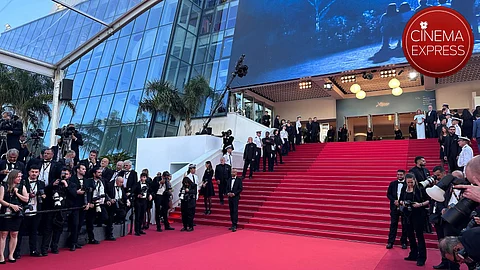Cannes Film Festival 2025: Goddess of small things
At first glance, the official Indian selection at the Cannes Film Festival this year did seem like a study in contrasts.
On the one hand was Neeraj Ghaywan’s indie-spirited Homebound, backed by a mainstream studio, Karan Johar’s Dharma Productions, featuring young Bollywood stars like Ishaan Khatter, Jahnavi Kapoor and Vishal Jethwa in the lead roles with Hollywood legend Martin Scorsese boarding it as Executive Producer. On the other was the immortal Indian icon, late Satyajit Ray, with his eighth film in Cannes—the restored Arnayer Din Ratri (Days and Nights in the Forest, 1970) in the Cannes Classics segment.
Tucked away in the middle of these biggies was a small student film in the La CineF section that highlights short and medium-length films made by students from leading film schools worldwide. Called A Doll Made Up of Clay, it has been produced by Sahil Ingle and directed by Kokob Gebrehaweria Tesfay, both students of Satyajit Ray Film and Television Institute of India, Kolkata. What’s more, it was made at zero budget as an academic project for the “Producing for Film and Television” department of the Post Graduate Programme in Cinema.
“The challenge is to mobilise manpower and resources both from within the institute and outside to make the film with barely any monetary support,” said Ingle, who was at Cannes with some members of the film’s team. “It was an amazing learning experience. We get to learn the value of time and resources,” he added, about the unique exercise and a one-of-its-kind department.
About Oluwaseyi (Ibrahim Ahmed), a Nigerian footballer who comes to India to make a career in the game, only to find his dreams getting shattered on suffering an incurable leg injury, the 24-minute abstract, experimental film deals with the metaphorical journey back to his roots to seek hope, health and healing in ancient rituals.
Parallel to it are his Indian associations—his source of comfort away from loneliness, discrimination and privation, Geeta (Geeta Doshi, one of the professional actors in the film who worked gratis) with her own inner demons—and the several brushes with Indian culture, spirituality and music, especially with an old maker of Durga idols.
The themes of origin and lineage; displacement and loss; identity and belonging; reconnection, rehabilitation and continuities; camaraderie, fellowship and, above all, a place called home coalesce in the form of the clay statues of Durga.
The holy clay is like a spiritual key, as Gebrehaweria Tesfay marries African myths and fables with Hindu imagery. Whispering, and the efforts of Oluwaseyi to hear those murmurs, run through the entire film, underscoring the oral storytelling tradition of Ethiopia that’d find an echo in India as well. The soundtrack uses popular music—“Naa jeo naa”, the Bengali version of Shailendra-Salil Chowdhary-Lata Mangeshkar song “O Sajna” from Bimal Roy’s Parakh (1960) or “Sangi je ke”, the Bengali rendition of “Lag jaa gale”, the Raja Mehdi Ali Khan-Madan Mohan-Lata Mangeshkar song from Raj Khosla’s Woh Kaun Thi? (1964).
No wonder the film is unique in platforming cultural diversity not just when it comes to India, but for being an extraordinary international creative collaboration that helps consolidate and highlight SRFTI as a global centre for cinema studies.
The diversity is in a mix of the West African Yoruba and Bengali languages. The film’s protagonist is Nigerian—Ahmed is a footballer-turned-non-professional actor in real life on whom writer-director Gebrehaweria Tesfay had made a documentary earlier. Tesfay himself is an Ethiopian student under the ICCR (Indian Council for Cultural Relations) African Scholarship and the editor, Haru/Mahmud Abu Naser, is from Bangladesh.
When it comes to the Indian team, producer Ingle is from Akola, Maharashtra, the executive producer Uma Kumari hails from Rewari in Haryana, music director Himangshu Saikia comes from Assam, cinematographer Vinod Kumar is from Punjab and sound recording, design and mix is credited to Soham Pal from West Bengal.
Talking of short films and a global platform, the only other short from South Asia to feature in the Cannes official selection has been from our neighbour Bangladesh. A Bangladesh-Philippines co-production, Adnan Al Rajeev’s Ali, about a teenager’s unique protest against ban on singing, hasn’t just been the first film from the country to have been selected in the shorts competition but it also bagged a special mention in the category.
Meanwhile, the independent sidebar, Quinzaine des cineastes aka Directors’ Fortnight, featured an avant garde Pakistani short, Karmash, by Pakistani visual artist, writer and filmmaker Aleem Bukhari. A rare Pakistani genre indie that one has come to see, it’s about the last heir of the Karmash tribe, played by Irfan Noor K with a feral intensity, and his peregrination in the city. His physical wandering parallels the inner journey of the mind, back to the past—to his memories, ancestry, inheritances and identity. The city, reduced to a wasteland and rubble, seemingly reflects his own breakdown and the fragmented narrative evokes his fractured being. But is he truly a freak or are we being made to see him as the grotesque “other”? Who is sane and who is the scavenger? Is he the one degenerating or is it the world around him that’s in decay? Bukhari calls his surreal indie, a “subliminal political allegory”. “I intended to capture the subject of repressed identity and persecution of minorities,” he writes in the director’s note. An urgent portrait of the trauma of the oppressed, that packs in several layers of meaning in its monochromatic images.


